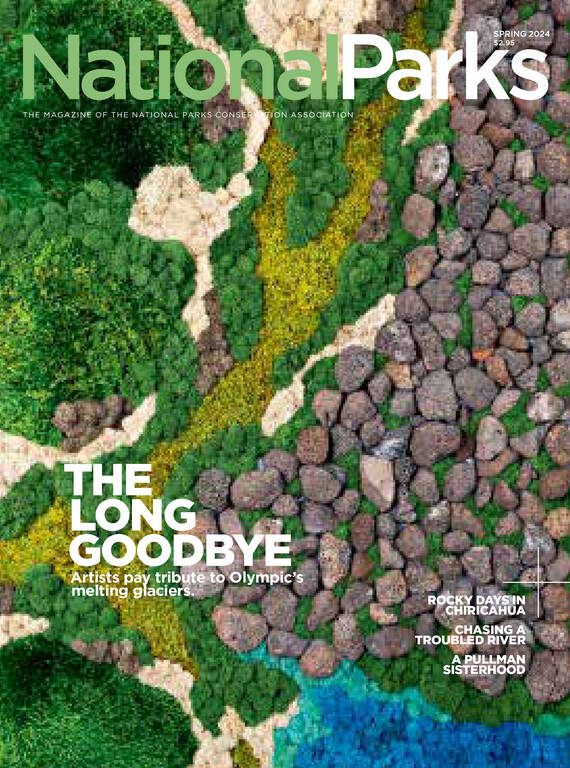Spring 2024
Weary Traveler
For 18 years, Kurt Repanshek’s passion has been the engine behind National Parks Traveler. But unless more reliable funding surfaces by this summer, he plans to walk away from the publication.
The first week Kurt Repanshek posted stories about national parks on a makeshift blog, he attracted more than 400 readers. “With no marketing, no announcement, nothing,” he said. “It just really encouraged me that there was obviously a thirst for this type of content.”
That was more than 18 years ago. A former Associated Press reporter, Repanshek was working as a freelance writer at the time, but the media industry was going through some seismic shifts, and magazine gigs were starting to dry up. Meanwhile, interest in National Parks Traveler, as he’d christened it, continued to grow. At some point, with the writing on the wall, he decided to go all in on the Traveler.
Since then, Repanshek has transformed the blog into a full-fledged, independent online media outlet with daily news, features, guides, e-books, an app and a podcast. He publishes 1,100-odd stories every year, has produced more than 250 podcast episodes, and boasts between 2 million and 3 million annual readers and listeners. (Legacy newspapers and magazines often pick up his stories — and spread the word far beyond that, Repanshek pointed out.) The Traveler doesn’t only run easy-to-produce news stories on, say, search-and-rescue operations or misguided visitors who attempt to pet bison. To be sure, Repanshek is not above pushing out a quick hit based on a National Park Service press release, but he often publishes stories that dig into the meaty, complex issues that park sites face from climate change to visitation to morale among employees.
“He’s looking into things in the Park Service at a level of depth and policy sophistication that is just lacking,” said Bob Krumenaker, who retired last year as superintendent of Big Bend National Park. “I don’t always love what he publishes, but I think he’s the only one who’s doing anything like that. And it’s critically important to the Service and to the public who cares about national parks.”
But the park news empire that Repanshek has painstakingly built may be about to come crashing down. After years of running the Traveler on a shoestring and serving as the only paid employee, Repanshek, who turned his business into a nonprofit in 2016, is tired of constantly chasing after funding, which primarily comes from individual donors. (Other contributors include park friend groups and NPCA, which gave a $7,500 matching grant last year.) A push this winter brought in enough money to keep the lights on for six more months, but Repanshek said that if he isn’t able to raise around $200,000 by June to hire a proper staff and pay for freelancers and other costs, he’s going to call it quits.
“I’ve been kidding myself for all these years — next year, it’s gonna be better. … And it’s never gotten better,” he said. “Somebody told me that there’s plenty of billionaires out there who love national parks. I haven’t found one yet.”
The archive of thousands of stories will also go dark, Repanshek said, because even that requires “care and feeding,” and he can’t picture keeping it up himself without funding. “The problem that the Traveler faces is that one person can’t do it all. There are just so many moving parts between editorial and marketing and development and the whole IT thing and the daily generation of content,” Repanshek said. “It’s just not sustainable.”
Over the years, various people have pitched in on a volunteer basis to write, photograph and otherwise work behind the scenes, but Repanshek, who is 67, has decided he needs considerably more help. “Part of the problem is burnout. You know, just pure burnout,” he said.
One thing that frustrates Repanshek is that only a tiny portion of the site’s millions of consumers donate. But even if most readers aren’t responding to his pleas for dollars, it is clear from perusing comments that a lot of them genuinely care about what he’s doing.
“The cost of closing the National Parks Traveler is so much greater than the cost of operating it,” one reader wrote. “Let’s not let that happen.”
In a recent phone call, Repanshek relayed the publication’s origin story — tracing back to his first inkling about the magic of national parks. He recounted how, as a kid growing up in New Jersey, he read a story in National Geographic about a winter caretaker living deep in Yellowstone. “Turning the pages, I struggled to comprehend a landscape where snow falls so frequently, so deeply, that someone must shovel it from atop cabins and lodges,” he wrote in a story about the very same winter keeper, which he published in the Traveler in 2005.
The first big landscape park Repanshek visited was Acadia National Park in Maine. He has a vivid though possibly unreliable memory of his father using rungs to hoist himself up a difficult trail — with their poodle under his arm. In the ensuing years, nature continued to exert its pull on Repanshek: He worked as a river guide in West Virginia during college and envisioned becoming a wildlife biologist. But undergraduate chemistry proved to be an insurmountable obstacle, so he veered into journalism and immediately was smitten. “It was like second nature for me,” he said.
Part of the problem is burnout. You know, just pure burnout.
In 1993, Repanshek moved to Utah for his wife’s job and decided to pursue a freelance career. Based in Park City, he wrote a lot about skiing, but he was also frequently pitching environmental stories to magazines. Focusing on national parks felt like a natural step from there. He’d written “America’s National Parks for Dummies,” which came out in 2003, and he knew that parks could provide reams of rich material. Initially, he used the then-blog to track conservation issues and develop ideas, but before long, the Traveler assumed a life of its own.
Recently, the Traveler has published notable pieces about invasive species, the impact of oil exploration on Florida’s Big Cypress National Preserve, the park system’s repair backlog and the pitfalls of Recreation.gov. (Questionable fees that line the pockets of contractors instead of going to the parks is an issue that gets readers fired up.) For several years running, Repanshek has published an annual “threatened and endangered parks” package to highlight places at great risk due to threats such as overcrowding and sea-level rise.

National Parks
You can read this and other stories about history, nature, culture, art, conservation, travel, science and more in National Parks magazine. Your tax-deductible membership donation of $25 or more entitles…
See more ›Davitt Woodwell, the former president of the Pennsylvania Environmental Council, initially stumbled across the Traveler by chance — as many hardcore park junkies do — and, impressed by the coverage, ended up becoming a board member. “If you follow it, it allows you to become a better public lands owner,” he said.
Repanshek’s dream (beyond finding that billionaire) is to train someone to take over as editor-in-chief, which would allow him to pull emeritus status and semi-retire to travel and send dispatches from parks around the country, preferably overlooked gems. Get him going, and he’ll happily rattle off a wish list that includes Little River Canyon National Preserve in Alabama, Organ Pipe Cactus National Monument in Arizona and Pictured Rocks National Lakeshore in Michigan. With the 250th anniversary of the country fast approaching, he’d also like to visit all of the park units that highlight Revolutionary War history.
“There are so many wonderful places in the park system that people are unaware of,” he said. “It’s just finding the time to get out to them.”
About the author
-
 Rona Marech Editor-in-Chief
Rona Marech Editor-in-ChiefRona Marech is the editor-in-chief of National Parks, NPCA’s award-winning magazine. Formerly a staff writer at the Baltimore Sun and the San Francisco Chronicle, Rona joined NPCA in 2013.


